Which Drivers Control the Suspended Sediment Flux in a High Arctic Glacierized Basin (Werenskioldbreen, Spitsbergen)?
Abstract
:1. Introduction
- (1)
- how high discharge events, such as intense snowmelt and heavy rainfall, modify the suspended sediment transport in a polythermal glacier basin,
- (2)
- where are the main sediment sources during floods throughout the hydrologically active season in the examined basin.
2. Study Area
3. Methods
3.1. Discharge and Meteorological Data
3.2. Suspended Matter Sampling and Laboratory Analysis
3.3. Methods of Estimation of the Suspended Sediment Concentration and Load
3.4. Hysteresis Index for Peak Runoff Events
4. Results
4.1. Suspended Sediment Transport during Hydrologically Active Seasons (2007–2012)
4.2. Distribution of SSC, SSL, and Runoff during the Hydrologically Active Season
4.3. Snowmelt- and Rain-Induced Suspended Sediment Peaks: Suspended Sediment Flux during Large Floods
4.4. Hysteresis Relationship during Peaks
5. Discussion
5.1. The Course of SSC during the Hydrologically Active Season
5.2. Heavy Rainfalls Accelerate Mechanical Denudation
5.3. Subglacial Sediment Resources
5.4. Mechanical Denudation in Werenskioldbreen and Other Glacierized Basins
5.5. Future Changes in the Suspended Sediment Yields from Glacierized Basins
6. Conclusions
Author Contributions
Funding
Acknowledgments
Conflicts of Interest
References
- Stott, T.; Mount, N. Alpine proglacial suspended sediment dynamics in warm and cool ablation seasons: Implications for global warming. J. Hydrol. 2007, 332, 259–270. [Google Scholar] [CrossRef]
- Schiefer, E.; Kaufman, D.; McKay, N.; Retelle, M.; Werner, A.; Roof, S. Fluvial suspended sediment yields over hours to millennia in the High Arctic at proglacial Lake Linnévatnet, Svalbard. Earth Surf. Process. Landf. 2018, 43, 482–498. [Google Scholar] [CrossRef]
- Syvitski, J.P.M.; Burrell, D.C.; Skei, J.M. Fjords: Processes and Products; Springer: Berlin, Germany, 1987; Volume 20, ISBN 978-1-4612-4632-9. [Google Scholar]
- Hawkings, J.; Wadham, J.; Tranter, M.; Telling, J.; Bagshaw, E.; Beaton, A.; Simmons, S.-L.; Chandler, D.; Tedstone, A.; Nienow, P. The Greenland ice sheet as a hot spot of phosphorus weathering and export in the Arctic. Glob. Biogeochem. Cycles 2016, 30, 191–210. [Google Scholar] [CrossRef]
- Hawkings, J.R.; Wadham, J.L.; Benning, L.G.; Hendry, K.R.; Tranter, M.; Tedstone, A.; Nienow, P.; Raiswell, R. Ice sheets as a missing source of silica to the polar oceans. Nat. Commun. 2017, 8. [Google Scholar] [CrossRef] [PubMed]
- Hawkings, J.R.; Wadham, J.L.; Tranter, M.; Lawson, E.; Sole, A.; Cowton, T.; Tedstone, A.J.; Bartholomew, I.; Nienow, P.; Chandler, D.; et al. The effect of warming climate on nutrient and solute export from the Greenland ice sheet. Geochem. Perspect. Lett. 2015, 1, 94–104. [Google Scholar] [CrossRef]
- Hawkings, J.R.; Wadham, J.L.; Tranter, M.; Raiswell, R.; Benning, L.G.; Statham, P.J.; Tedstone, A.; Nienow, P.; Lee, K.; Telling, J. Ice sheets as a significant source of highly reactive nanoparticulate iron to the oceans. Nat. Commun. 2014, 5. [Google Scholar] [CrossRef] [PubMed] [Green Version]
- Wadham, J.L.; Hawkings, J.; Telling, J.; Chandler, D.; Alcock, J.; O’Donnell, E.; Kaur, P.; Bagshaw, E.; Tranter, M.; Tedstone, A.; et al. Sources, cycling and export of nitrogen on the Greenland ice sheet. Biogeosciences 2016, 13, 6339–6352. [Google Scholar] [CrossRef]
- Guillon, H.; Mugnier, J.L.; Buoncristiani, J.F. Proglacial sediment dynamics from daily to seasonal scales in a glaciated alpine catchment (bossons glacier, Mont Blanc massif, France). Earth Surf. Process. Landf. 2018, 43, 1478–1495. [Google Scholar] [CrossRef]
- Costa, A.; Molnar, P.; Stutenbecker, L.; Bakker, M.; Silva, T.A.; Schlunegger, F.; Lane, S.N.; Loizeau, J.L.; Girardclos, S. Temperature signal in suspended sediment export from an Alpine catchment. Hydrol. Earth Syst. Sci. 2018, 22, 509–528. [Google Scholar] [CrossRef] [Green Version]
- Irvine-Fynn, T.D.L.; Moorman, B.J.; Willis, I.C.; Sjogren, D.B.; Hodson, A.J.; Mumford, P.N.; Walter, F.S.A.; Williams, J.L.M. Geocryological processes linked to High Arctic proglacial stream suspended sediment dynamics: Examples from Bylot Island, Nunavut, and Spitsbergen, Svalbard. Hydrol. Process. 2005, 19, 115–135. [Google Scholar] [CrossRef]
- Hodson, A.J.; Ferguson, R.I. Fluvial suspended sediment transport from cold and warm-based glaciers in Svalbard. Earth Surf. Process. Landf. 1999, 24, 957–974. [Google Scholar] [CrossRef]
- Favaro, E.A.; Lamoureux, S.F. Downstream patterns of suspended sediment transport in a High Arctic river influenced by permafrost disturbance and recent climate change. Geomorphology 2015, 246, 359–369. [Google Scholar] [CrossRef]
- Drewry, D.J. Glacial Geologic Processes; Hodder Arnold: London, UK, 1985; pp. 1–288. ISBN 978-0713164855. [Google Scholar]
- Hallet, B.; Hunter, L.; Bogen, J. Rates of erosion and sediment evacuation by glaciers: A review of field data and their implications. Glob. Planet. Chang. 1996, 12, 213–235. [Google Scholar] [CrossRef]
- Bogen, J.; Bønsnes, T.E. Erosion and sediment transport in High Arctic rivers, Svalbard. Polar Res. 2003, 22, 175–189. [Google Scholar] [CrossRef]
- Hodgkins, R. Seasonal trend in suspended-sediment transport from an Arctic glacier, and implications for drainage-system structure. Ann. Glaciol. 1996, 22, 147–151. [Google Scholar] [CrossRef] [Green Version]
- Hodson, A.; Gurnell, A.; Tranter, M.; Bogen, J.; Hagen, J.O.; Clark, M. Suspended sediment yield and transfer processes in a small High-Arctic glacier basin, Svalbard. Hydrol. Process. 1998, 12, 73–86. [Google Scholar] [CrossRef]
- Vatne, G.; Etzelmüller, B.; Sollid, J.L.; Ødegård, R.S. Meltwater routing in a High Arctic glacier, Hannabreen, northern Spitsbergen. Nor. Geografisk Tidsskri. Norw. J. Geogr. 1996, 50, 67–74. [Google Scholar] [CrossRef]
- Ladegaard-Pedersen, P.; Sigsgaard, C.; Kroon, A.; Abermann, J.; Skov, K.; Elberling, B. Suspended sediment in a High-Arctic river: An appraisal of flux estimation methods. Sci. Total Environ. 2017, 580, 582–592. [Google Scholar] [CrossRef] [PubMed]
- Mao, L.; Carrillo, R. Temporal dynamics of suspended sediment transport in a glacierized andean basin. Geomorphology 2017, 287, 116–125. [Google Scholar] [CrossRef]
- Pälli, A.; Moore, J.C.; Jania, J.; Kolondra, L.; Głowacki, P. The drainage pattern of Hansbreen and Werenskioldbreen, two polythermal glaciers in Svalbard. Polar Res. 2003, 22, 355–371. [Google Scholar] [CrossRef]
- Hodgkins, R. Controls on suspended sediment transfer at a High Arctic glacier, determined from statistical modelling. Earth Surf. Process. Landf. 1999, 24, 1–21. [Google Scholar] [CrossRef]
- Hodgkins, R.; Cooper, R.; Wadham, J.; Tranter, M. Suspended sediment fluxes in a High-Arctic glacierised catchment: Implications for fluvial sediment storage. Sediment. Geol. 2003, 162, 105–117. [Google Scholar] [CrossRef]
- Sawada, M.; Johnson, P.G. Hydrometeorology, suspended sediment and conductivity in a large glacierized basin, Slims River, Yukon Territory, Canada (1993–94). Arctic 2000, 53, 101–117. [Google Scholar] [CrossRef]
- Syvitski, J.P.M. Sediment discharge variability in arctic rivers: Implications for a warmer future. Polar Res. 2002, 21, 323–330. [Google Scholar] [CrossRef]
- Szpikowski, J.; Szpikowska, G.; Zwoliński, Z.; Rachlewicz, G.; Kostrzewski, A.; Marciniak, M.; Dragon, K. Character and rate of denudation in a High Arctic glacierized catchment (Ebbaelva, Central Spitsbergen). Geomorphology 2014, 218, 52–62. [Google Scholar] [CrossRef]
- Leggat, M.S.; Owens, P.N.; Stott, T.A.; Forrester, B.J.; Déry, S.J.; Menounos, B. Hydro-meteorological drivers and sources of suspended sediment flux in the pro-glacial zone of the retreating Castle Creek glacier, Cariboo Mountains, British Columbia, Canada. Earth Surf. Process. Landf. 2015, 40, 1542–1559. [Google Scholar] [CrossRef]
- Jania, J. Klasyfikacja i cechy morfometryczne lodowców otoczenia Hornsundu, Spitsbergen. In Wyprawy Polarne Uniwersytetu Śląskiego 1980–1984; University of Silesia: Katowice, Poland, 1988; Volume 2, pp. 12–47. ISBN 8322602308. [Google Scholar]
- Ignatiuk, D. Bilans Energetyczny Powierzchni Lodowca a Zasilanie Systemu Drenażu Glacjalnego Werenskioldbreen. The Energy Balance of the Glacier Surface and Water Supply of Drainage System of Werenskioldbreen. Ph.D. Thesis, University of Silesia, Sosnowiec, Poland, 2012. [Google Scholar]
- Hagen, J.O.; Liestol, O.; Roland, E.; Jorgensen, T. Glacier Atlas of SVALBARD and Jan Mayen; Norsk Polarinstitutt: Oslo, Norway, 1993; ISBN 82-7666-066-5. [Google Scholar]
- Grabiec, M. Stan i Współczesne Zmiany Systemów Lodowcowych Południowego Spitsbergenu w Świetle Badań Metodami Radarowym. The State and Contemporary Changes of the Glacial Systems in Southern Spitsbergen in the Light of the Radar Methods; Wydawnictwo Uniwersytetu Śląskiego: Katowice, Poland, 2017; Volume 3536, pp. 1–328. ISBN 978-83-226-3014-3. [Google Scholar]
- Stachnik, Ł.; Yde, J.C.; Kondracka, M.; Ignatiuk, D.; Grzesik, M. Glacier naled evolution and relation to the subglacial drainage system based on water chemistry and GPR surveys (Werenskioldbreen, SW Svalbard). Ann. Glaciol. 2016, 57, 19–30. [Google Scholar] [CrossRef]
- Piechota, A.M.; Sitek, S.; Ignatiuk, D.; Piotrowski, J.A. Reconstructing subglacial drainage of Werenskiold glacier (SW Spitsbergen) based on numerical modelling. Biuletyn Państwowego Instytutu Geologicznego 2012, 451, 191–202. [Google Scholar]
- Birkenmajer, K. Geology of Hornsund area, Spitsbergen 1:75000; University of Silesia: Katowice, Poland, 1990. [Google Scholar]
- Czerny, J.; Kieres, A.; Manecki, M.; Rajchel, J. Geological map of the SW part of Wedel-Jarlsberg Land, Spitsbergen. In Institute of Geology and Mineral Deposits; Manecki, A., Ed.; University of Mining and Metallurgy: Kraków, Poland, 1993. [Google Scholar]
- Kabala, C.; Zapart, J. Initial soil development and carbon accumulation on moraines of the rapidly retreating Werenskiold glacier, SW Spitsbergen, Svalbard Archipelago. Geoderma 2012, 175–176, 9–20. [Google Scholar] [CrossRef]
- Kowalska, A.; Soroka, W. Sedimentary environment of the Nottinghambukta delta, SW Spitsbergen. Pol. Polar Res. 2008, 29, 245–259. [Google Scholar]
- Bukowska-Jania, E. The role of glacier system in migration of calcium carbonate on Svalbard. Pol. Polar Res. 2007, 28, 137–155. [Google Scholar]
- Stachnik, Ł.; Majchrowska, E.; Yde, J.C.; Nawrot, A.; Cichała-Kamrowska, K.; Ignatiuk, D.; Piechota, A. Chemical denudation and the role of sulfide oxidation at Werenskioldbreen, Svalbard. J. Hydrol. 2016, 538, 177–193. [Google Scholar] [CrossRef] [Green Version]
- Szynkiewicz, A.; Modelska, M.; Buczyński, S.; Borrok, D.M.; Merrison, J.P. The polar sulfur cycle in the Werenskioldbreen, Spitsbergen: Possible implications for understanding the deposition of sulfate minerals in the north polar region of mars. Geochim. Cosmochim. Acta 2013, 106, 326–343. [Google Scholar] [CrossRef]
- Majchrowska, E.; Ignatiuk, D.; Jania, J.; Marszałek, H.; Wasik, M. Seasonal and interannual variability in runoff from the Werenskioldbreen catchment, Spitsbergen. Pol. Polar Res. 2015, 36, 197–224. [Google Scholar] [CrossRef] [Green Version]
- Hornsund Glacio−Topoclim Database. Available online: http://www.glacio-topoclim.org/ (accessed on 31 August 2012).
- Meteorological Bulletins of the Institute of Geophysics of the Polish Academy of Sciences. Available online: https://hornsund.igf.edu.pl/Biuletyny/ (accessed on 28 August 2018).
- The International Organization for Standardization (ISO). Water Quality—Determination of Suspended Solids—Method by Filtration through Glass-Fibre Filters; ISO: Vernier, Switzerland, 1997. [Google Scholar]
- Folk, R.L.; Ward, W.C. Brazos river bar, a study in the significance of grain size parameters. J. Sediment. Res. 1957, 27, 3–26. [Google Scholar] [CrossRef]
- Willis, I.C. Rating curve. In Encyclopedia of Snow, Ice and Glaciers; Singh, V.P., Singh, P., Haritashya, U.K., Eds.; Springer Netherlands: Dordrecht, The Netherlands, 2011; pp. 918–922. ISBN 978-90-481-2642-2. [Google Scholar]
- Skarbøvik, E.; Stålnacke, P.; Bogen, J.; Bønsnes, T.E. Impact of sampling frequency on mean concentrations and estimated loads of suspended sediment in a norwegian river: Implications for water management. Sci. Total Environ. 2012, 433, 462–471. [Google Scholar] [CrossRef] [PubMed]
- McDonald, D.M.; Lamoureux, S.F. Hydroclimatic and channel snowpack controls over suspended sediment and grain size transport in a High Arctic catchment. Earth Surf. Process. Landf. 2009, 34, 424–436. [Google Scholar] [CrossRef]
- Berthling, I.; Etzelmüller, B. The changing cryosphere—Implications for solute and sedimentary fluxes in cold climate environments. In Source-to-Sink Fluxes in Undisturbed Cold Environments; Beylich, A.A., Dixon, J.C., Zwoliński, Z., Eds.; Cambridge University Press: Cambridge, UK, 2016; pp. 13–29. ISBN 9781107068223. [Google Scholar]
- Pulina, M. Preliminary studies on denudation in SW Spitsbergen. Bull. Acad. Pol. Sci. Terre 1974, 22, 83–99. [Google Scholar]
- Krawczyk, W.; Opołka-Gądek, J. Suspended sediment concentration in the Werenskiold glacier drainage basin in 1986. In XXI Polar Symposium; Zalewski, M.S., Ed.; Institute of Geophysics Polish Academy of Sciences: Warszawa, Poland, 1994; pp. 215–224. ISBN 8385173374. [Google Scholar]
- Lawler, D.M.; Petts, G.E.; Foster, I.D.L.; Harper, S. Turbidity dynamics during spring storm events in an urban headwater river system: The upper tame, west midlands, UK. Sci. Total Environ. 2006, 360, 109–126. [Google Scholar] [CrossRef] [PubMed]
- Riihimaki, C.A.; MacGregor, K.R.; Anderson, R.S.; Anderson, S.P.; Loso, M.G. Sediment evacuation and glacial erosion rates at a small alpine glacier. J. Geophys. Res. Earth Surf. 2005, 110. [Google Scholar] [CrossRef] [Green Version]
- Jansson, P.; Rosqvist, G.; Schneider, T. Glacier fluctuations, suspended sediment flux and glacio-lacustrine sediments. Geogr. Ann. Ser. A Phys. Geogr. 2005, 87, 37–50. [Google Scholar] [CrossRef]
- Leszkiewicz, J.; Caputa, Z. The thermal condition of the active layer in the permafrost at Hornsund, Spitsbergen. Pol. Polar Res. 2004, 25, 223–239. [Google Scholar]
- Liermann, S.; Beylich, A.A.; van Welden, A. Contemporary suspended sediment transfer and accumulation processes in the small proglacial sætrevatnet sub-catchment, Bødalen, western Norway. Geomorphology 2012, 167–168, 91–101. [Google Scholar] [CrossRef]
- Haritashya, U.K.; Singh, P.; Kumar, N.; Gupta, R.P. Suspended sediment from the Gangotri glacier: Quantification, variability and associations with discharge and air temperature. J. Hydrol. 2006, 321, 116–130. [Google Scholar] [CrossRef]
- Richards, K. Some observations on suspended sediment dynamics in Storbregrova, Jotunheimen. Earth Surf. Process. Landf. 1984, 9, 101–112. [Google Scholar] [CrossRef]
- Dugan, H.A.; Lamoureux, S.F.; Lafrenière, M.J.; Lewis, T. Hydrological and sediment yield response to summer rainfall in a small High Arctic watershed. Hydrol. Process. 2009, 23, 1514–1526. [Google Scholar] [CrossRef]
- Wawrzyniak, T.; Osuch, M.; Napiórkowski, J.; Westermann, S. Modelling of the thermal regime of permafrost during 1990–2014 in Hornsund, Svalbard. Pol. Polar Res. 2016, 37, 219–242. [Google Scholar] [CrossRef] [Green Version]
- Piroznikow, E.; Gorniak, A. Changes in the characteristics of the soil and vegetation during the primary succession in the marginal zone of the Werenskiold glacier, Spitsbergen. Pol. Polar Res. 1992, 13, 19–29. [Google Scholar]
- Bogen, J. Glacial sediment production and development of hydro-electric power in glacierized areas. Ann. Glaciol. 1989, 13, 6–11. [Google Scholar] [CrossRef]
- Sollid, J.L.; Etzelmüller, B.; Vatne, G.; Ødegård, R. Glacial dynamics, material transfer and sedimentation of Erikbreen and hannabreen, Liefdefjorden, northern Spitsbergen. Z. Geomorphol. Suppl. Issue B 1994, 97, 123–144. [Google Scholar]
- Kjeldsen, O. Materialtransportundersckelser i Norske Breelver 1980; Vassdragsdirektor Hydrologisk Avdeling: Oslo, Norway, 1981. [Google Scholar]
- Elverhøi, A.; Svendsen, J.I.; Solheim, A.; Andersen, E.S.; Milliman, J.; Mangerud, J.; Hooke, R.L. Late quaternary sediment yield from the High Arctic Svalbard area. J. Geol. 1995, 103, 1–17. [Google Scholar] [CrossRef]
- Dixon, J.C. Contemporary solute and sedimentary fluxes in arctic and subarctic environments: Current knowledge. In Source-to-Sink Fluxes in Undisturbed Cold Environments; Beylich, A.A., Dixon, J.C., Zwoliński, Z., Eds.; Cambridge University Press: Cambridge, UK, 2016; pp. 39–51. ISBN 9781107068223. [Google Scholar]
- Nuth, C.; Moholdt, G.; Kohler, J.; Hagen, J.O.; Kääb, A. Svalbard glacier elevation changes and contribution to sea level rise. J. Geophys. Res. Earth Surf. 2010, 115. [Google Scholar] [CrossRef] [Green Version]
- Nuth, C.; Kohler, J.; König, M.; Von Deschwanden, A.; Hagen, J.O.; Kääb, A.; Moholdt, G.; Pettersson, R. Decadal changes from a multi-temporal glacier inventory of Svalbard. Cryosphere 2013, 7, 1603–1621. [Google Scholar] [CrossRef] [Green Version]
- Błaszczyk, M.; Jania, J.A.; Kolondra, L. Fluctuations of tidewater glaciers in hornsund fjord (southern svalbard) since the beginning of the 20th century. Pol. Polar Res. 2013, 34, 327–352. [Google Scholar] [CrossRef]
- Łupikasza, E. Long-term variability of precipitation form in Hornsund (Spitsbergen) in relation to atmospheric circulation (1979–2009). Bull. Geogr. Phys. Geogr. Ser. 2010, 3, 65–86. [Google Scholar] [CrossRef]
- Osuch, M.; Wawrzyniak, T. Climate projections in the Hornsund area, southern Spitsbergen. Pol. Polar Res. 2016, 37, 379–402. [Google Scholar] [CrossRef]
- Beylich, A.A.; Gintz, D. Effects of high-magnitude/low-frequency fluvial events generated by intense snowmelt or heavy rainfall in Arctic periglacial environments in northern swedish lapland and northern Siberia. Geogr. Ann. Ser. A Phys. Geogr. 2004, 86, 11–29. [Google Scholar] [CrossRef]
- Knudsen, N.T.; Yde, J.C.; Gasser, G. Suspended sediment transport in glacial meltwater during the initial quiescent phase after a major surge event at Kuannersuit glacier, Greenland. Geografisk Tidsskri. Dan. J. Geogr. 2007, 107, 1–7. [Google Scholar] [CrossRef]
- Beylich, A.A.; Dixon, J.C.; Zwoliński, Z. Summary of key findings from arctic, antarctic, and mountain environments. In Source-to-Sink Fluxes in Undisturbed Cold Environments; Beylich, A.A., Dixon, J.C., Zwoliński, Z., Eds.; Cambridge University Press: Cambridge, UK, 2016; pp. 398–399. ISBN 9781107068223. [Google Scholar]
- Legeżyńska, J.; Włodarska-Kowalczuk, M.; Głuchowska, M.; Ormańczyk, M.; Kędra, M.; Węsławski, J.M. The malacostracan fauna of two Arctic fjords (west Spitsbergen): The diversity and distribution patterns of its pelagic and benthic components. Oceanologia 2017, 59, 541–564. [Google Scholar] [CrossRef]
- Meire, L.; Mortensen, J.; Meire, P.; Juul-Pedersen, T.; Sejr, M.K.; Rysgaard, S.; Nygaard, R.; Huybrechts, P.; Meysman, F.J.R. Marine-terminating glaciers sustain high productivity in Greenland fjords. Glob. Chang. Biol. 2017, 23, 5344–5357. [Google Scholar] [CrossRef] [PubMed] [Green Version]
- Hopwood, M.J.; Carroll, D.; Browning, T.J.; Meire, L.; Mortensen, J.; Krisch, S.; Achterberg, E.P. Non-linear response of summertime marine productivity to increased meltwater discharge around Greenland. Nat. Commun. 2018, 9, 3256. [Google Scholar] [CrossRef] [PubMed]
- Irvine-Fynn, T.D.L.; Hodson, A.J.; Moorman, B.J.; Vatne, G.; Hubbard, A.L. Polythermal glacier hydrology: A review. Rev. Geophys. 2011, 49. [Google Scholar] [CrossRef]
- Navarro, F.J.; Martín-Español, A.; Lapazaran, J.J.; Grabiec, M.; Otero, J.; Vasilenko, E.V.; Puczko, D. Ice volume estimates from ground-penetrating radar surveys, Wedel Jarlsberg Land glaciers, Svalbard. Arct. Antarct. Alp. Res. 2014, 46, 394–406. [Google Scholar] [CrossRef]
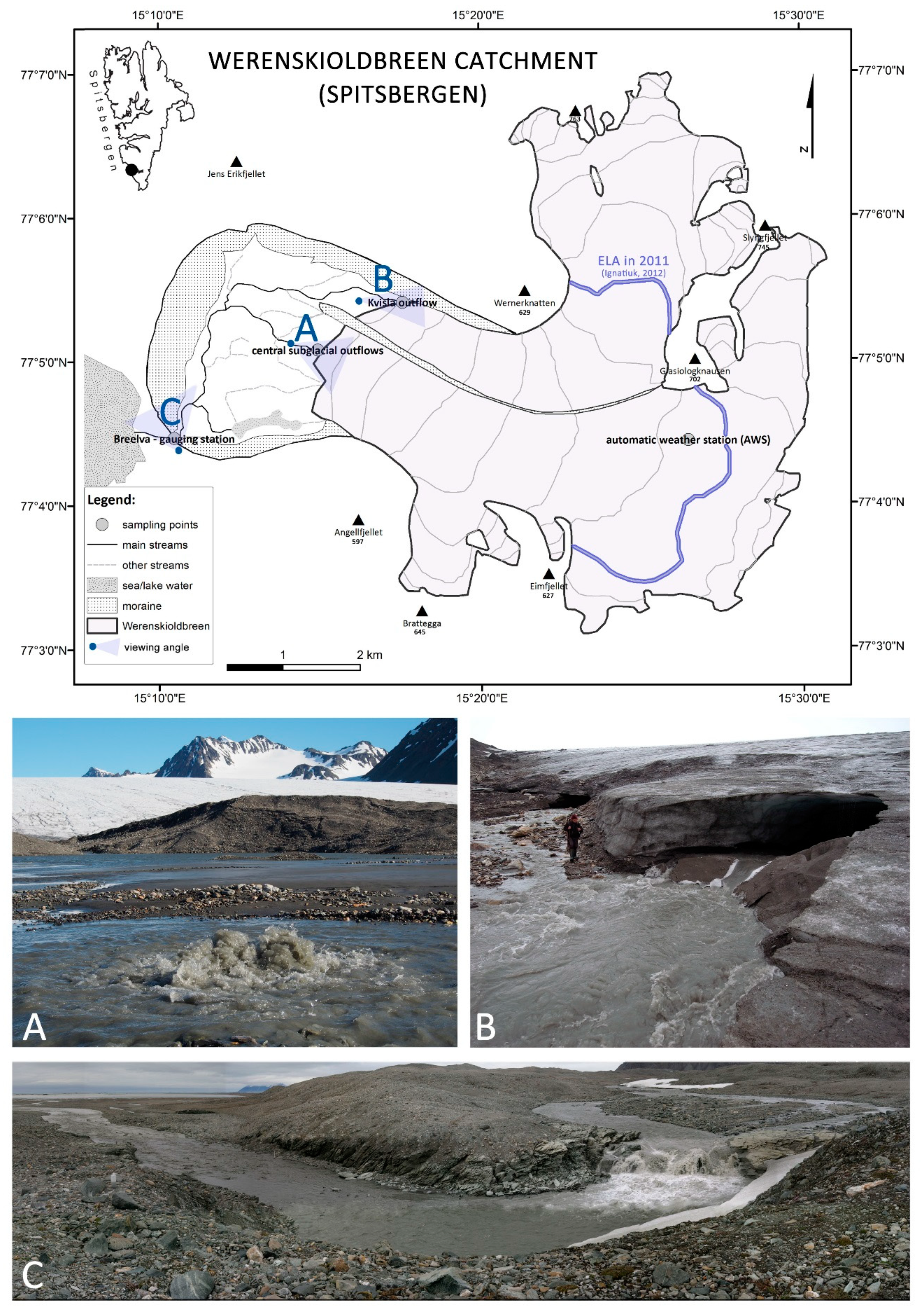
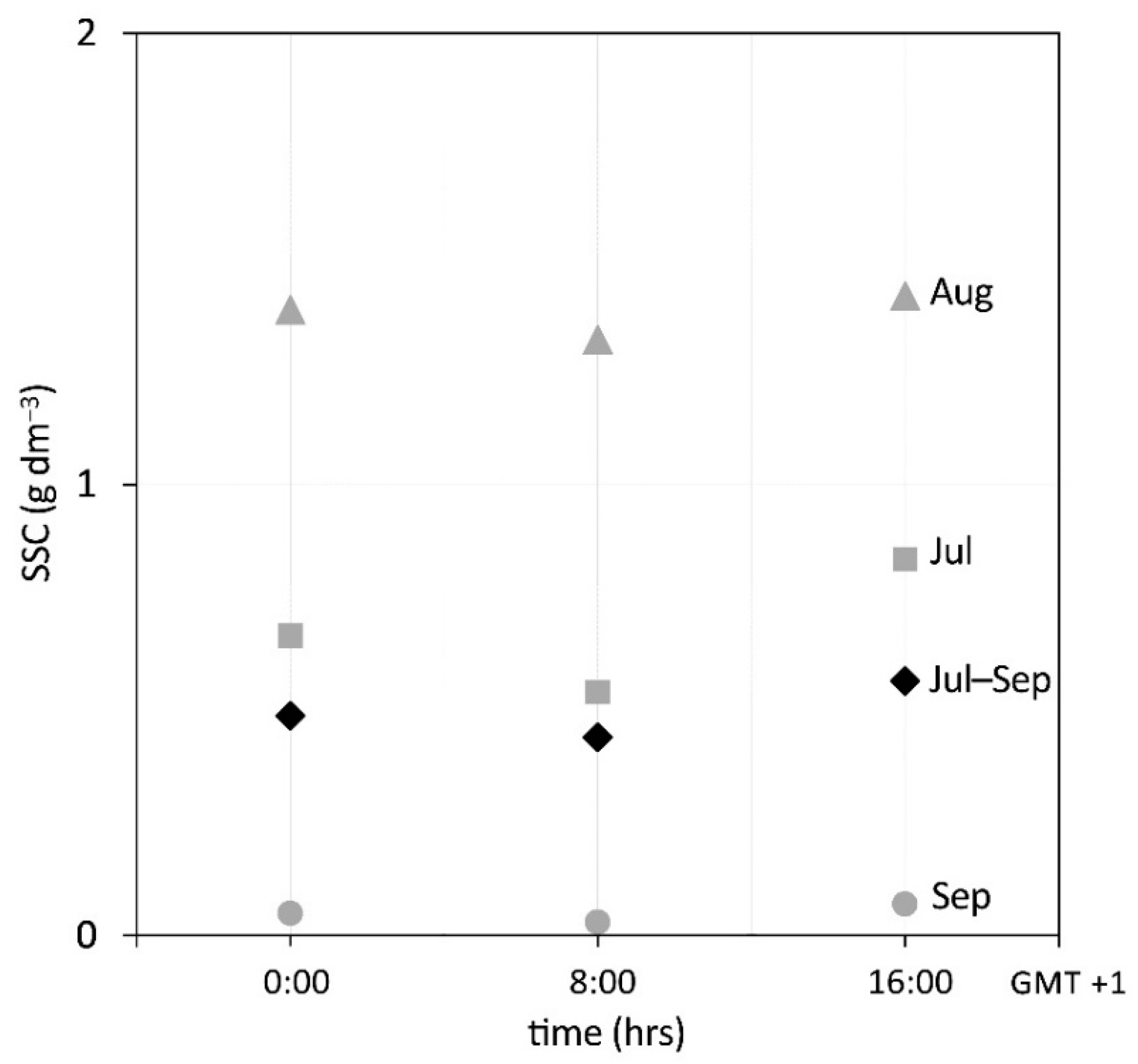
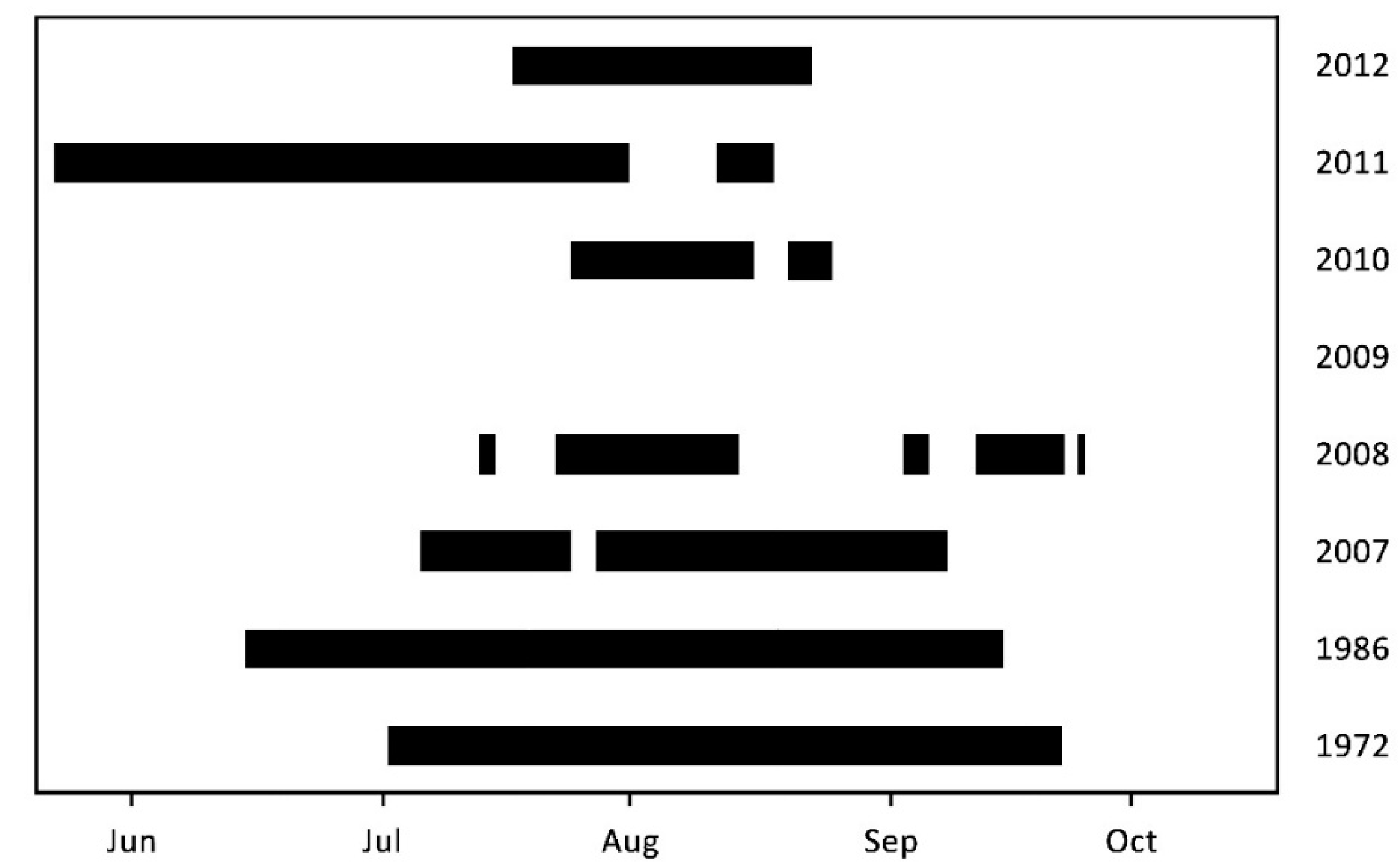
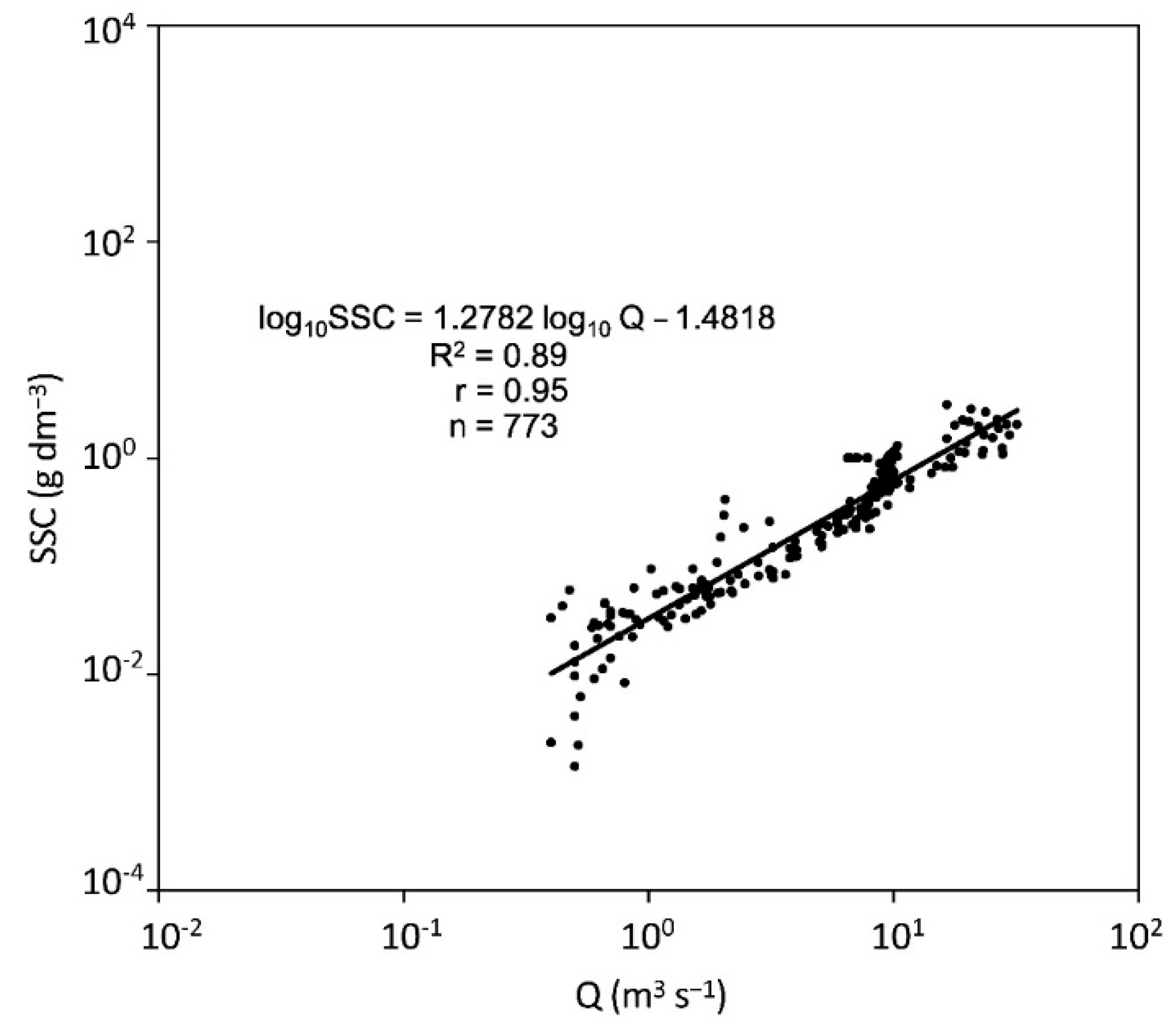
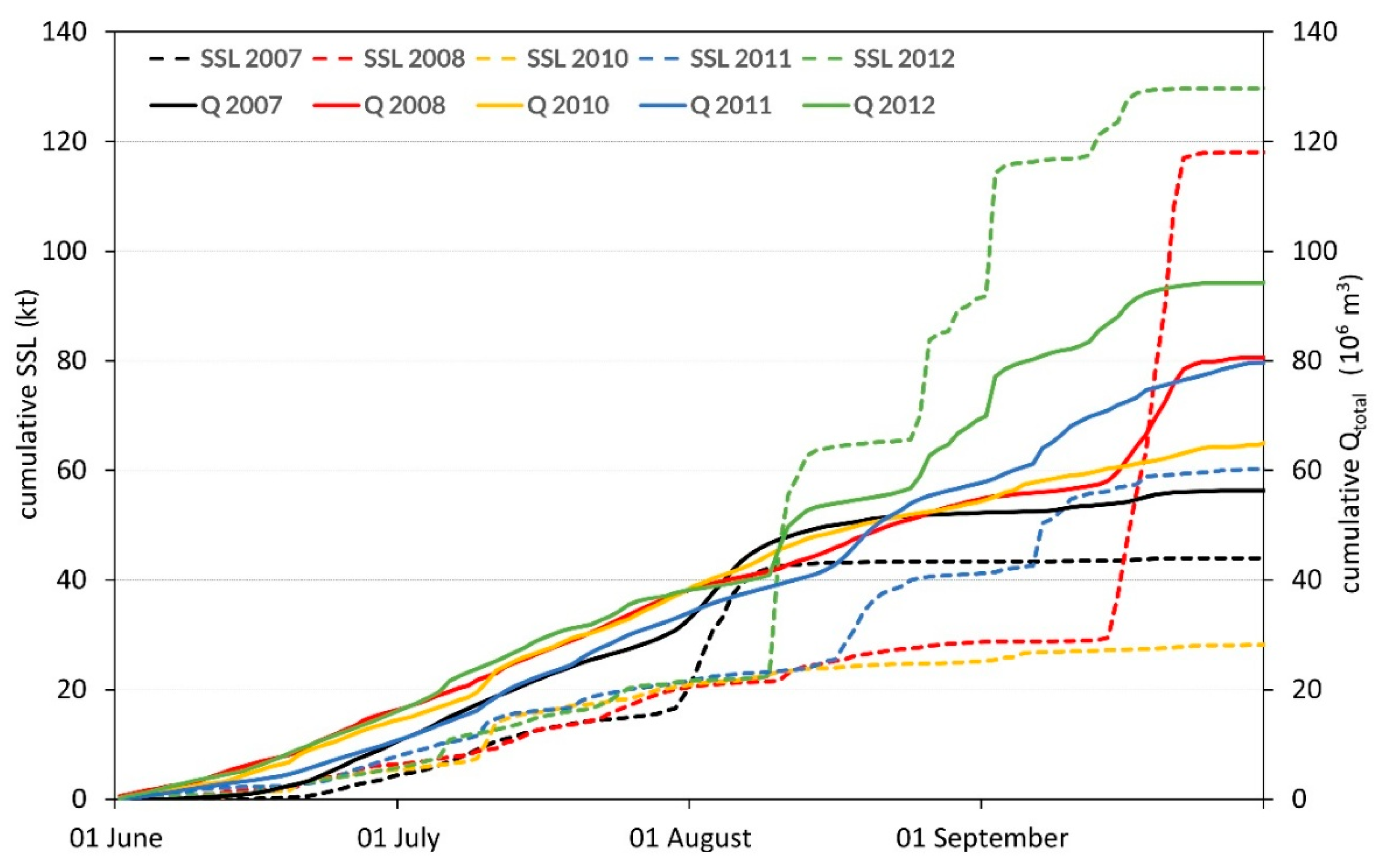
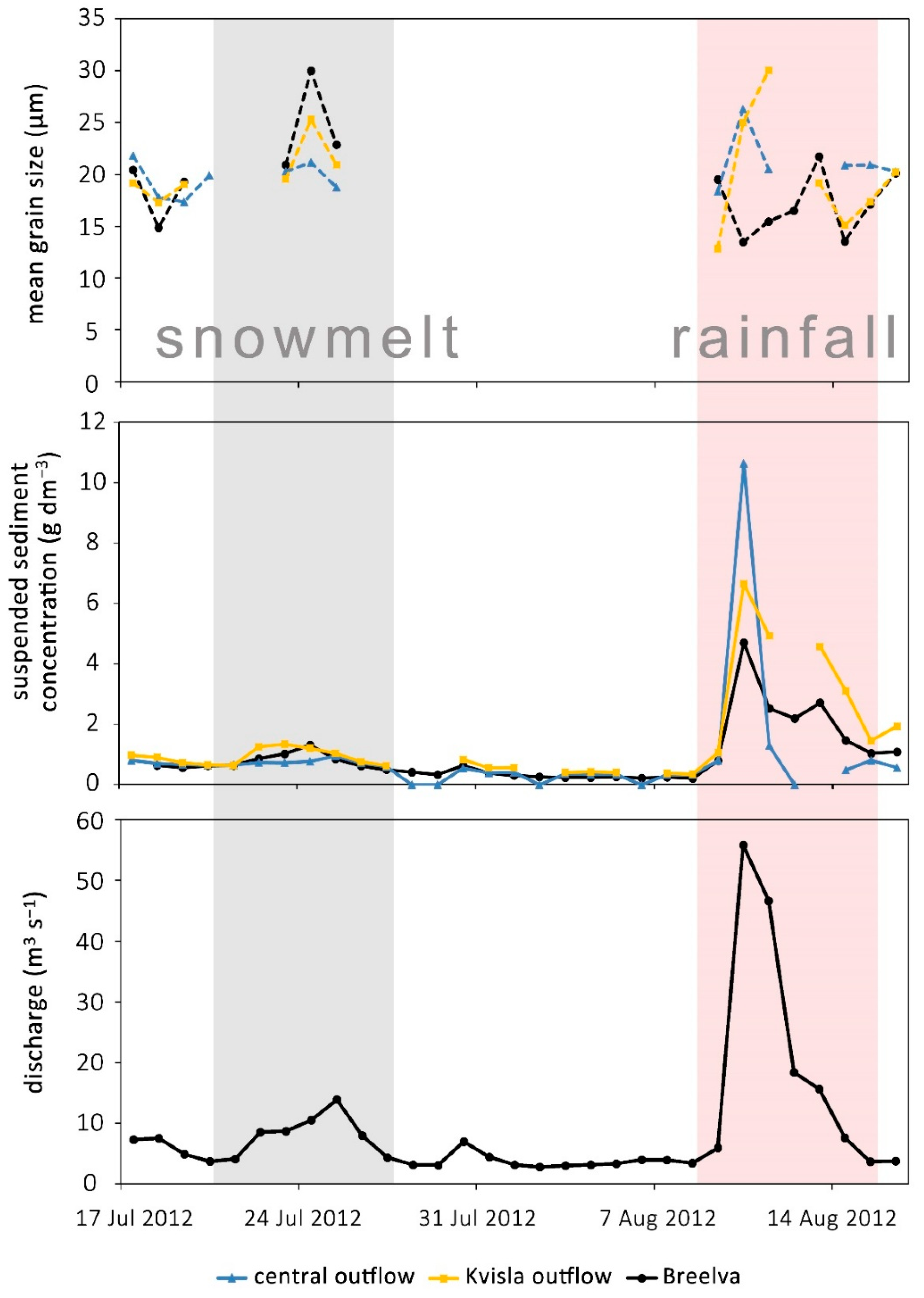
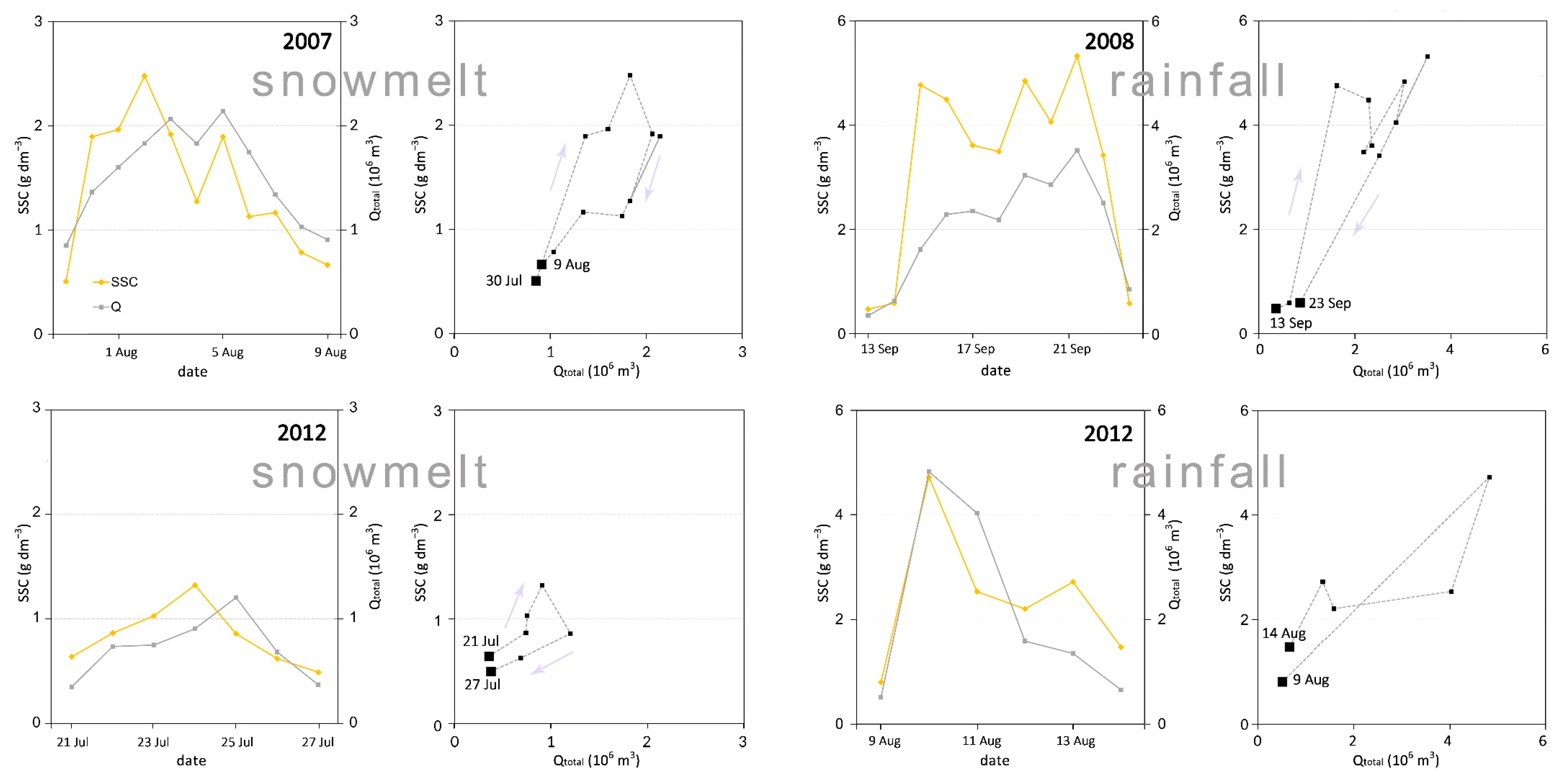
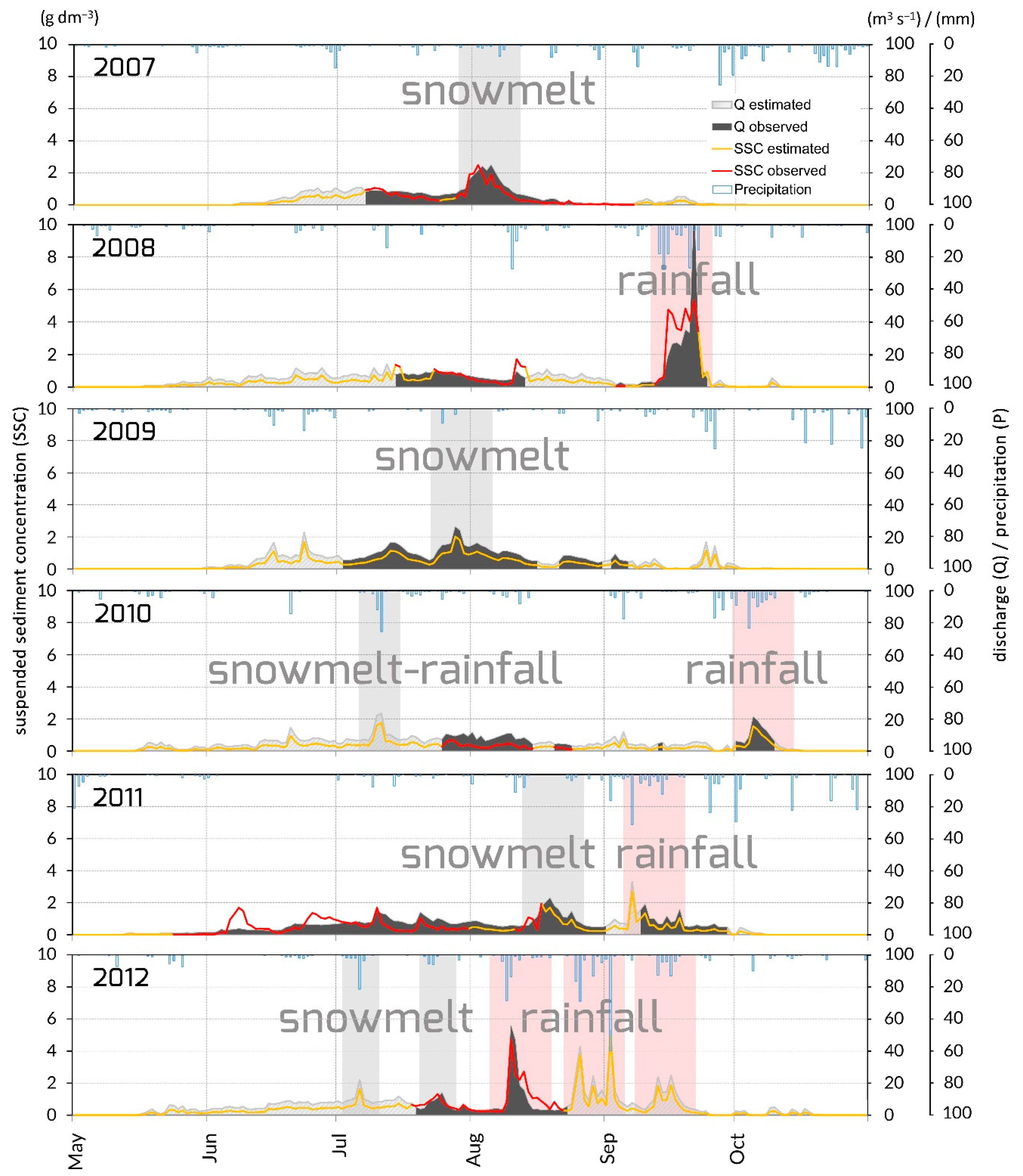
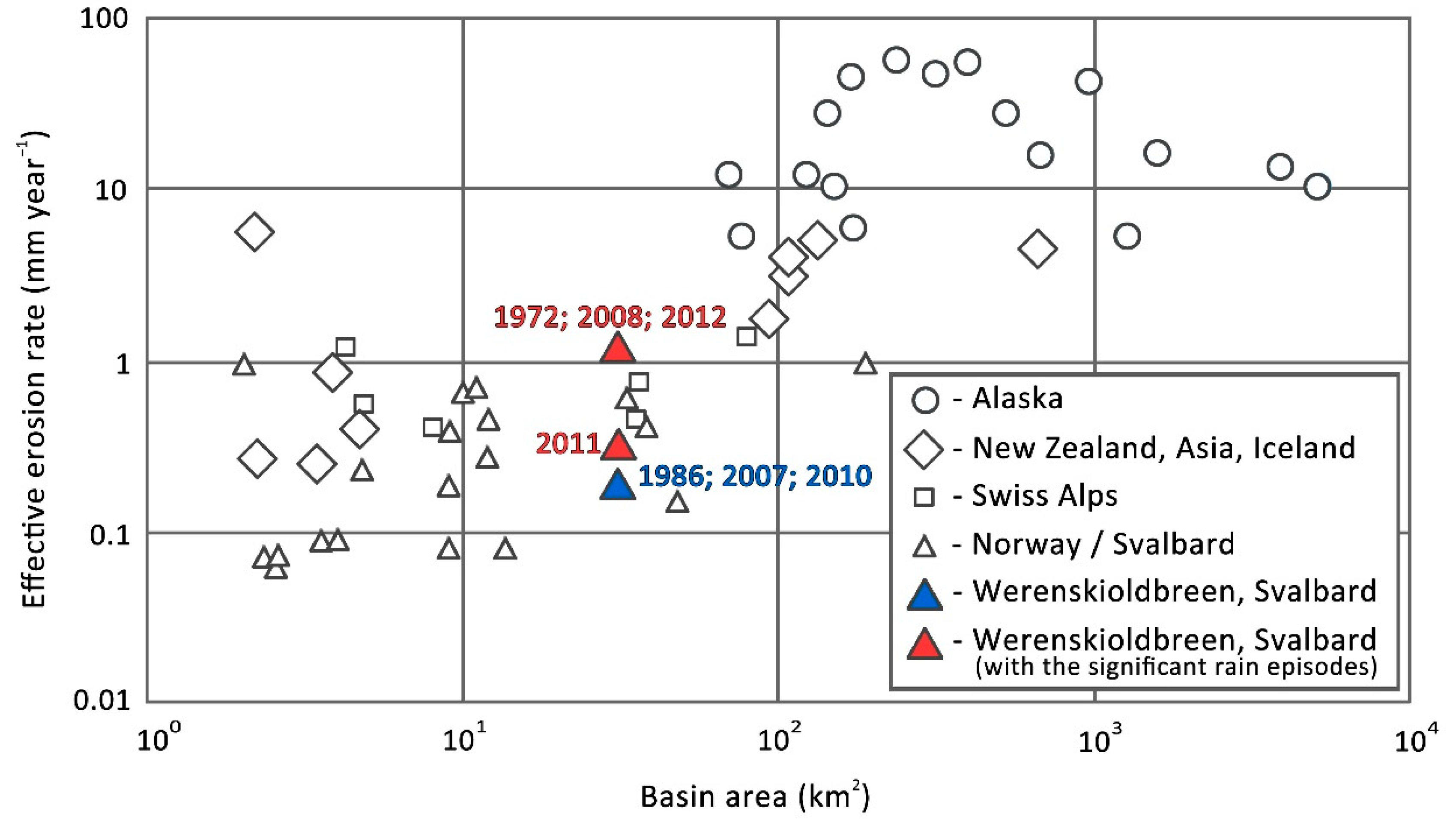
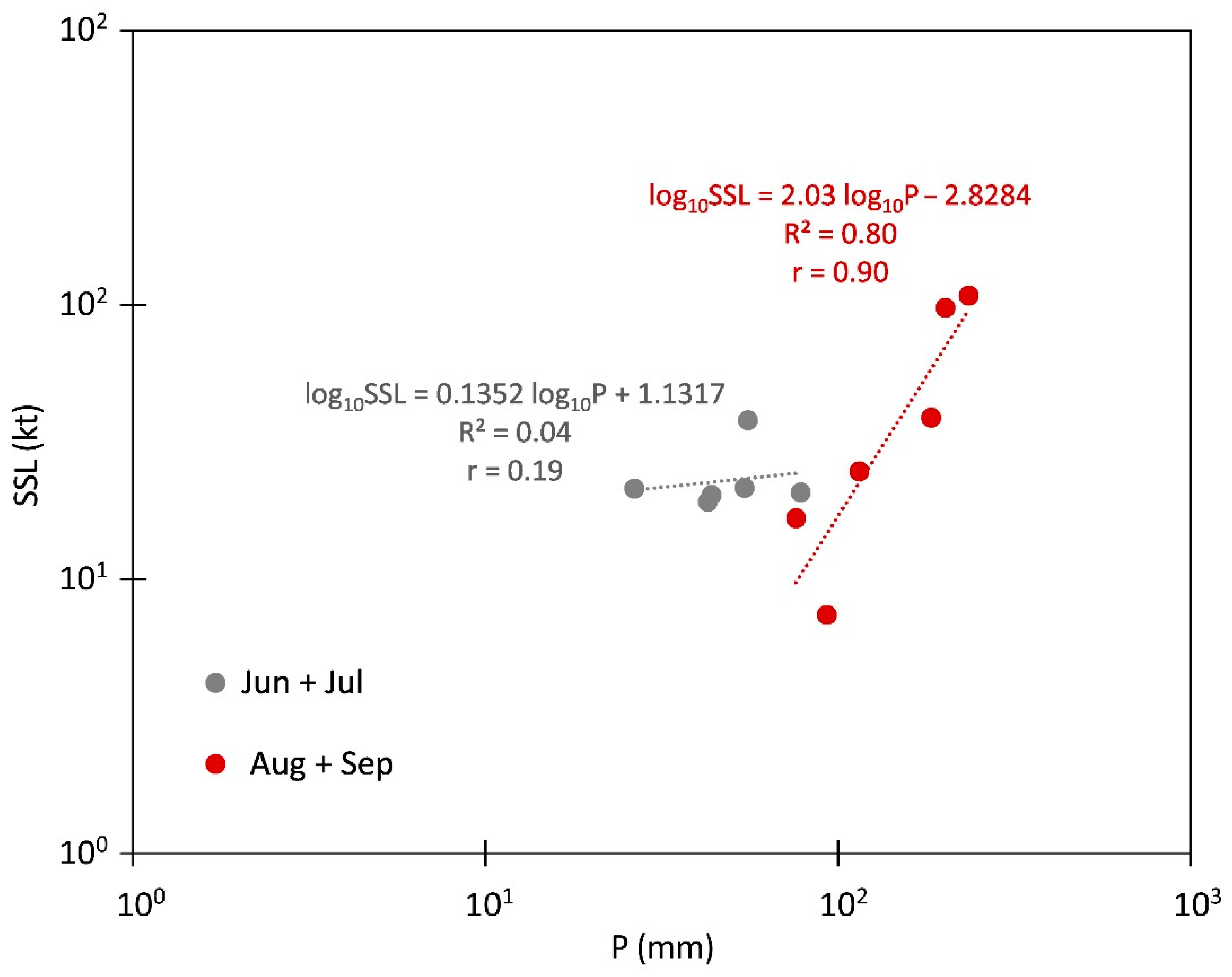
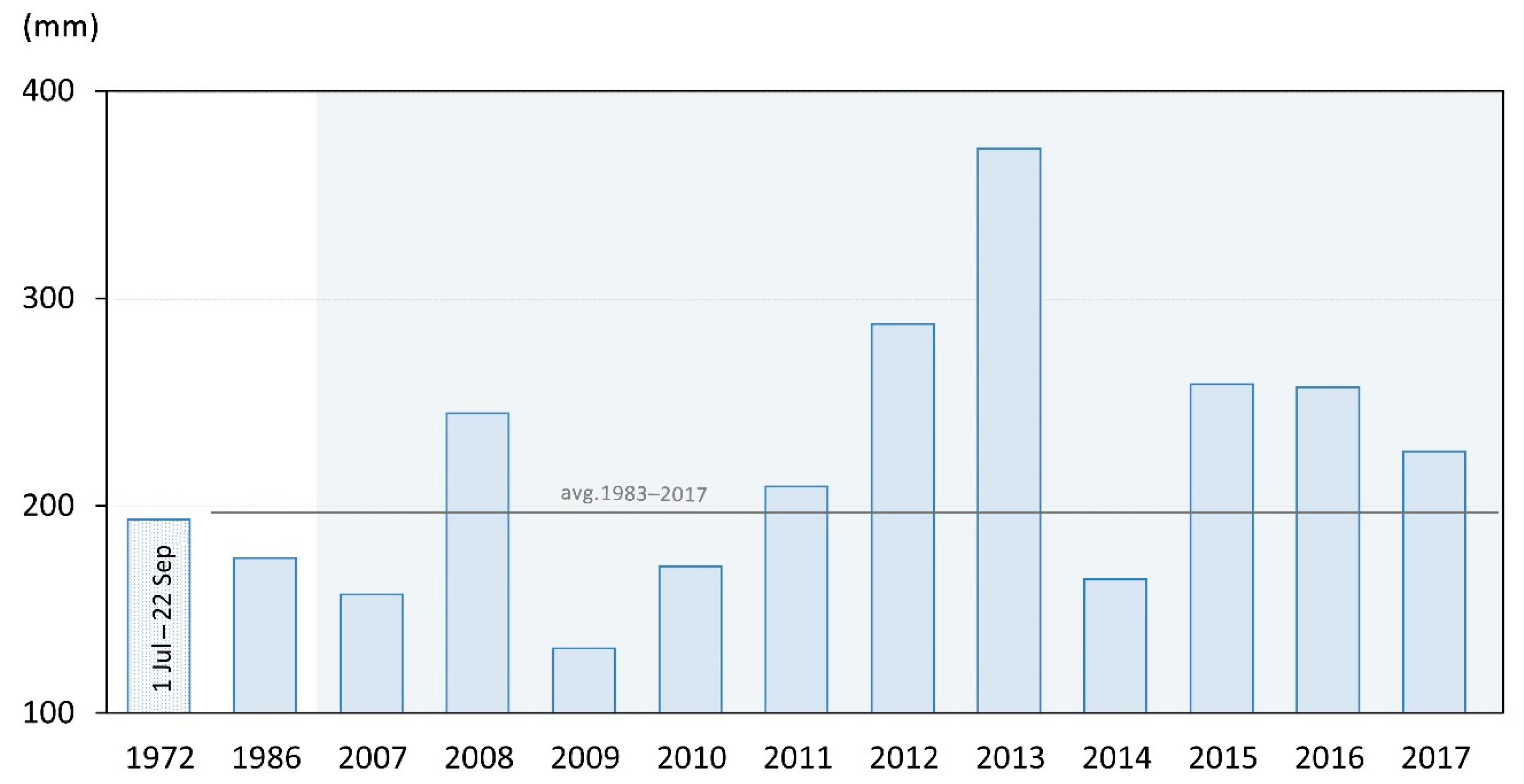
| Year | Period of Sampling (Date Range and Number of Days) | Suspended Sediment Concentration (SSC) (g dm−3) | Suspended Sediment Load (SSL) (kt) | Mechanical Denudation (t km−2) a | Mechanical Denudation (mm Year −1) b | Total Annual Runoff (Qtotal) (106 m3) ** | Source |
|---|---|---|---|---|---|---|---|
| 1972 | 3.07–21.09 (81 days) | >1.000 | [51] | ||||
| 1986 | 16.06–14.09 (91 days) | 0.045–3.630 | 40.25 | 914.8 | 0.366 | ~50 | [52] |
| 2007 | 7–24.07; 28.07–7.09 (60 days) | 0.011–2.478 | 36.52 (43.95 *) | 830.00 (998.87 *) | 0.332 (0.400 *) | 56.37 | this study |
| 2008 | 14–15.07; 23.07–13.08; 3–5.09; 12–22.09; 24.09 (39 days) | 0.043–5.313 | 107.26 (118.46 *) | 2437.73 (2692.32 *) | 0.975 (1.077 *) | 84.04 | this study |
| 2009 | - | - | 57.71 * | 1243 * | 0.497 * | 78.91 | - |
| 2010 | 25.07–15.08; 20–24.08 (27 days) | 0.109–0.674 | 6.56 (37.30 *) | 149.09 (847.68 *) | 0.060 (0.339 *) | 78.35 | this study |
| 2011 | 24.05–31.07; 11–17.08 (76 days) | 0.001–1.930 | 28.35 (60.23 *) | 644.31 (1368.79 *) | 0.258 (0.548 *) | 82.28 | this study |
| 2012 | 18.07–22.08 (36 days) | 0.217–4.718 | 49.89 (130.94 *) | 1133.86 (2975.91 *) | 0.454 (1.190 *) | 98.71 | this study |
| Year | % of SSC (Date) | ||||
| SSC 10% | SSC 25% | SSC 50% | SSC 75% | SSC 90% | |
| 2007 | 26 Jun | 8 Jul | 28 Jul | 4 Aug | 11 Aug |
| 2008 | 26 Jun | 21 Jul | 24 Aug | 18 Sep | 21 Sep |
| 2010 | 20 Jun | 8 Jul | 27 Jul | 5 Sep | 29 Sep |
| 2011 | 12 Jun | 29 Jun | 31 Jul | 26 Aug | 12 Sep |
| 2012 | 27 Jun | 19 Jul | 12 Aug | 30 Aug | 13 Sep |
| Year | % of Runoff (Qtotal) (Date) | ||||
| Qtotal 10% | Qtotal 25% | Qtotal 50% | Qtotal 75% | Qtotal 90% | |
| 2007 | 25 Jun | 6 Jul | 27 Jul | 6 Aug | 19 Aug |
| 2008 | 20 Jun | 8 Jul | 7 Aug | 16 Sep | 21 Sep |
| 2010 | 20 Jun | 9 Jul | 31 Jul | 4 Sep | 29 Sep |
| 2011 | 26 Jun | 13 Jul | 13 Aug | 5 Sep | 17 Sep |
| 2012 | 21 Jun | 10 Jul | 11 Aug | 2 Sep | 15 Sep |
| Year | Lag Time (Days) | ||||
| SSC 10%–Qtotal 10% | SSC 25%–Qtotal 25% | SSC 50%–Qtotal 50% | SSC 75%–Qtotal 75% | SSC 90%–Qtotal 90% | |
| 2007 | 1 day | 2 days | 1 days | −2 days | −8 days |
| 2008 | 6 days | 13 days | 17 days | 2 days | 0 days |
| 2010 | 0 day | −1 day | −4 days | 1 day | 0 day |
| 2011 | −14 days | −15 days | −9 days | −10 days | −5 days |
| 2012 | 6 days | 9 days | 1 day | −3 days | −2 days |
| Year | Qhigh discharge events * (106 m3) | Qtotal (106 m3) | Part of Qtotal (%) | SSLhigh discharge events (kt) | SSLtotal (kt) | Part of SSLtotal (%) |
|---|---|---|---|---|---|---|
| 2007 | 16.71 | 56.37 | 30 | 26.00 | 43.95 | 59 |
| 2008 | 22.19 | 84.04 | 26 | 88.56 | 118.46 | 75 |
| 2009 ** | 23.13 | 78.91 | 29 | 24.32 | 54.71 | 44 |
| 2010 | 15.46 | 78.35 | 20 | 16.37 | 37.30 | 44 |
| 2011 | 23.98 | 82.28 | 29 | 29.66 | 60.23 | 49 |
| 2012 | 48.00 | 98.71 | 49 | 108.80 | 130.94 | 83 |
| Flood Event | Qmax | Qmin | Qmid | SSCrl | SSCfl | HImid |
|---|---|---|---|---|---|---|
| 2007 snowmelt (k = 0.5) | 2.142 | 0.851 | 1.497 | 1.934 | 1.155 | 0.675 |
| 2008 rainfall (k = 0.5) | 3.512 | 0.356 | 1.934 | 4.649 | 2.439 | 0.906 |
| 2012 snowmelt (k = 0.5) | 1.203 | 0.359 | 0.781 | 1.071 | 0.669 | 0.601 |
| 2012 rainfall (k = 0.75) | 4.824 | 0.516 | 3.747 | 3.744 | 2.492 | 0.503 |
© 2018 by the authors. Licensee MDPI, Basel, Switzerland. This article is an open access article distributed under the terms and conditions of the Creative Commons Attribution (CC BY) license (http://creativecommons.org/licenses/by/4.0/).
Share and Cite
Łepkowska, E.; Stachnik, Ł. Which Drivers Control the Suspended Sediment Flux in a High Arctic Glacierized Basin (Werenskioldbreen, Spitsbergen)? Water 2018, 10, 1408. https://doi.org/10.3390/w10101408
Łepkowska E, Stachnik Ł. Which Drivers Control the Suspended Sediment Flux in a High Arctic Glacierized Basin (Werenskioldbreen, Spitsbergen)? Water. 2018; 10(10):1408. https://doi.org/10.3390/w10101408
Chicago/Turabian StyleŁepkowska, Elżbieta, and Łukasz Stachnik. 2018. "Which Drivers Control the Suspended Sediment Flux in a High Arctic Glacierized Basin (Werenskioldbreen, Spitsbergen)?" Water 10, no. 10: 1408. https://doi.org/10.3390/w10101408
APA StyleŁepkowska, E., & Stachnik, Ł. (2018). Which Drivers Control the Suspended Sediment Flux in a High Arctic Glacierized Basin (Werenskioldbreen, Spitsbergen)? Water, 10(10), 1408. https://doi.org/10.3390/w10101408





